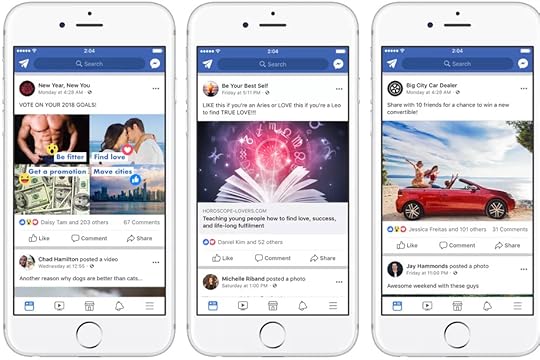Brian Meert's Blog, page 134
December 21, 2017
Intent and Repeat Viewership Now Boost Distribution of Facebook Videos
 December 22, 2017
December 22, 2017Anna Hubbel

So you’ve put in all the creative effort to make a stellar video. But as great as it may be, if it doesn’t appear in Facebook’s news feed, what good is a video that no one is going to see? That’s what Facebook’s two recent news feed updates aim to resolve. The two updates take user intent and repeat viewership into account when deciding which videos to increase distribution for in News Feed.
Intent & repeat viewership now boost distribution for #videos in @Facebook 's #NewsFeed.…
Click To Tweet
Facebook will now look at users’ active visits to your page to determine if videos should have higher distribution in news feed. Active visits include visiting the page directly or typing it in the search bar. For instance, if users frequently search for your page, Facebook will increase news feed distribution of videos that your page posts. If users return to watch your videos week after week, showing particular interest in videos that your page produces, Facebook will show those videos in news feed more than average.
This new prioritization of videos may help Facebook overcome its crowded news feed problem. The platform has already taken multiple steps towards alleviating this issue, including the rollout of Watch, Facebook’s new TV app for original shows.
When it comes to seeing success for your videos, however, Facebook can only help you with part of the battle. You can better your chances by following these four tips for creating great Facebook video ads.
The post Intent and Repeat Viewership Now Boost Distribution of Facebook Videos appeared first on AdvertiseMint.
Facebook Will Push Down Posts That Ask for Engagement
 December 22, 2017
December 22, 2017Anna Hubbel
 Posts that ask for engagement—likes, comments, and shares—are called engagement bait. Photo Courtesy of recode.
Posts that ask for engagement—likes, comments, and shares—are called engagement bait. Photo Courtesy of recode.Facebook has noticed the misleading clickbait posts that try to get users to like or share strictly for the purpose of boosting engagement numbers. And the network doesn’t like it.
Pages that use this kind of clickbait, referred to as engagement bait, typically use it in posts that reel users in with something like “Share this post if you love your mom.” Instead of being transparent, pages that use this practice are trying to increase their reach and engagement to get Facebook’s algorithm to place their posts higher up in news feed. According to recode, Facebook will now push engagement bait down in news feed, decreasing post reach and, subsequently, discouraging clickbait.
@Facebook now discourages engagement bait by pushing it down in #NewsFeed. #fakenews #clickbait
Click To Tweet
A More Transparent News Feed
This isn’t the first instance in which Facebook has taken action against misleading posts. In October, we learned the network was testing a button that gives contextual information to publishers’ articles that appear in news feed. Additionally, Facebook recently tested an “About the ad” button, which provides users with a list of ads purchased by an ad’s page owner.
With over two billion monthly users, Facebook’s platform may seem impossible to maintain when it comes to regulating transparency and eliminating fake news and posts with spam. But Facebook’s active pursuit of transparency and its installment of preventative measures seems to be helping.
The post Facebook Will Push Down Posts That Ask for Engagement appeared first on AdvertiseMint.
December 20, 2017
How FCC’s Net Neutrality Repeal Will Negatively Affect Your Business
 December 21, 2017
December 21, 2017Anne Felicitas
The #FCC 's #netneutrality repeal will negatively affect your #business. #entrepreneurs #politics
Click To Tweet

On Thursday, December 15, The Federal Communications Commission (FCC), repealed its net neutrality regulations, which prevented Internet service and wireless providers, such as Comcast, and AT&T, respectively, from discriminating against online content.
When the rules were intact, companies could not block or slow access to lawful content and could not charge websites and apps more to access fast lanes. For example, AT&T could not force customers to keep their cable plan by slowing Netflix or force them to use their cell minutes by slowing Skype. Additionally, they could not charge website owners more to reach Internet users faster.
Although Ajit Pai, the FCC’s chairman who argued for the repeal of net neutrality, claimed Internet and wireless providers would not slow access to content, with no rules protecting the net, those companies will likely do so. If fact, in 2005, AT&T CEO Ed Whiteacre said that “for a Google or a Yahoo or Vonage or anybody to expect to use these pipes [ability to reach users] for free is nuts.” And in 2013, Verizon told a federal court that it should charge websites any extra fees to reach its customers.
 Ajit Pai, chairman at the FCC, voted for the repeal of net neutrality. Photo courtesy of Daniel Acker/Bloomberg/Getty Images.
Ajit Pai, chairman at the FCC, voted for the repeal of net neutrality. Photo courtesy of Daniel Acker/Bloomberg/Getty Images.With the repeal of net neutrality, startups will struggle to grow. If Internet companies slow access to startups’ websites that are not paying extra for fast lanes, those startups will struggle to increase revenue and users when those users bounce to competitors’ faster websites. Although startups can pay extra for fast lanes, paying Internet providers extra fees each month could be too expensive for them to afford.
If a startup can’t grow fast enough because it can’t reach new customers, it will struggle to find investors, who only fund companies with growing users and revenue. In his newsletter, Jason Calacanis, an angel investor, defines the type of startup he invests in.
“We focus on investing in startups that have product or market fit and some traction. This could be $10,000 to $150,000 a month in revenue, or tens of thousands of daily free users,” said Calacanis.
It will be difficult for startups to gain thousands of revenue and users if they have to pay Internet providers extra fees or if they can’t reach customers because of slow lanes. With no money to pay extra fees and no revenue and customers to entice investors, startups won’t be able to compete against big competitors.
Although the FCC repealed net neutrality, public interest groups, politicians, and attorneys are fighting against it. While Public Knowledge, the National Hispanic Media Coalition, and the Internet Association promised to take legal action, Democrats on Capitol Hill are working on a bill that would reestablish the rules. Now, the fate of startups rests on those fighting the repeal.
The post How FCC’s Net Neutrality Repeal Will Negatively Affect Your Business appeared first on AdvertiseMint.
Why Trademarking Is the Best Thing to Do for Your Business
 December 21, 2017
December 21, 2017Deborah Sweeney
If you haven't already, trademark your unique assets. #business #USPTO #entreprenuers
Click To Tweet

Your business has intellectual property that it uses. Your unique assets may include logos, designs, or phrases. In the early stages of running your business, you will use your assets with your offerings to build your brand and establish awareness with consumers.
However, if you use your intellectual property on your offerings, but you have not trademarked any of your assets, you risk plagiarism by an outside source. If a third party used your same mark or created a similar one, your investment dollars could be used to benefit the competitor. You could also potentially infringe on someone else’s mark without even realizing it. Having a trademark on your logo or slogan avoids all of these issues, especially once your company begins to expand. It may cost a little extra, and the paperwork might take a bit of time to complete, but here’s why registering for a trademark with the United States Patent and Trademark Office (USPTO) is the best way to legally protect your brand.
1. Trademarks Have a Long Lifespan
Are there expiration dates for trademarks? The answer is no. Once you filed and registered your trademark with the USPTO, you can use a designation with the mark.
 A trademark logo appears as an R within a circle. Photo courtesy of khuranaandkhurana.com
A trademark logo appears as an R within a circle. Photo courtesy of khuranaandkhurana.comAs long as you file the required documents and pay any necessary fees, a trademark can protect your intellectual property for hundreds of years, which is good news for the original and distinct logos, slogans, and symbols you have associated with your business.
2. Used Marks Can Still Be Protected
Typically, new businesses that plan to publicize their services in the near future are encouraged to do research, ensuring the ideas are original and not infringing on other registrations, and file for a trademark early on. However, your mark can still be protected even if you already started using it. To do so, file under use-in-commerce basis if the mark is used in connection with your goods and services listed in your trademark application. Make sure to include an example of how the mark is used in connection with said goods and services, such as having the trademark visible on product packagings, labels, tags, or your displays in store.
3. Only You Can Use the Mark
Having a registered trademark is proof that the ideas you have are unique, keeping competitors from stealing or copying your original work. It also ensures that consumers do not confuse your assets with that of another business’, something that might be harder to distinguish if there is no trademark on the intellectual property. Once consumers know that you have the exclusive rights to that mark, your business builds its credibility while keeping the intellectual property safe and sound.
Deborah Sweeney is the CEO of MyCorporation, a leader in online legal filing services for entrepreneurs and business owners, providing startup bundles that include corporation and LLC formation, registered agent, DBA, and trademark and copyright filing services. You can follow Deborah Sweeney on Google+ and Twitter.
The post Why Trademarking Is the Best Thing to Do for Your Business appeared first on AdvertiseMint.
5 Ways to Create Trustworthy Facebook Ads
 December 20, 2017
December 20, 2017Anna Hubbel

The best way to grow any business through Facebook advertising is by building trust with users, aka potential customers. However, with the frequent discoveries of untrustworthy accounts distributing ads across social media, it can be challenging to make sure users know that you are a trustworthy business. To make sure your potential customers know that yours is, in fact, a trustworthy business, adhere to the following practices for creating trustworthy Facebook ads.
To make sure users know that you're a trustworthy business, use these 5 ways to make trustworthy @Facebook…
Click To Tweet
1. Eliminate Incorrect Grammar and Spelling Errors
If your ad copy has typos or incorrect grammar, users are not going to be impressed and will likely question your business’ credibility. In fact, one of the red flags that signaled an ad was a fake from Russia is grammatical errors. Avoid common grammatical errors that inexperienced copywriters make by double-checking and thoroughly proofreading your ad copy before publishing the ad.
2. Use High-Quality Images and Videos
Blurry or pixelated amateur photos or videos make your business look sloppy, unprofessional, and careless. Invest in making great video ads, as well as research how to make a top-notch photo. Your ad will be more polished as a result and will show customers that you know what you are doing.
3. Feature Customer Reviews on Your Ad Copies
To show customers you’re a trusted business, show them what others have said about their experiences with you. Including customer reviews in your ad both communicates that you are transparent and that others trust you. Do some research on how to grow customer reviews for your business.
4. Respond to Complaints in the Comments Section
Unfortunately, every business does receive a negative review now and then. However, by responding promptly to negative comments made on your ad, you can assure customers that you care and that you are able to address issues quickly and effectively. Use it as an opportunity to show the customer service skills of your business.
5. Do Not Include Misleading Information
Now more than ever, Facebook discourages and rejects ads that mislead users. Under no circumstances should you include any messages in your ad that are not 100 percent true and transparent. Strictly adhere to Facebook’s advertising policies for each ad you distribute for your business to ensure you are putting content out there that customers will trust.
The post 5 Ways to Create Trustworthy Facebook Ads appeared first on AdvertiseMint.
3 Unconventional Social Media Tricks to Try
 December 20, 2017
December 20, 2017Ksenia Newton
Have you tried these 3 unconventional #socialmedia tricks? #hacks #social #digitaladvertising…
Click To Tweet

It’s 2017—I no longer need to explain that having a social media presence is a necessity, not a luxury. I will go even further to say that social media improves consumers’ trust in businesses. If you are still uncertain about your company’s need to be on social media, consider the following.
Social media is visual.
Social media is free.
Social media contributes to SEO.
Social media has a large reach.
According to Statista, Facebook has 2.07 billion monthly active users, and Instagram is accountable for over 800 million people. Combined, these two platforms have an unbeatable insight into your potential target. If you decide to advertise on Facebook, you will have a higher chance of gaining much needed exposure in the largest pool of potential customers for your company.
3 Social Media Tricks You’re Probably Not Using
We know all too well how hard it is to juggle multiple projects without seeing the immediate results. Here are a few effective tactics that you can incorporate into your social media strategy.
1. Amplifying Attention
You created a sales piece or an interesting blog post. Now what? You sent emails to subscribers, existing clients, and friends and posted your content on Facebook, waiting for users to like, comment, and share. It doesn’t work this way anymore because the Internet is cluttered. They say the ratio should be 30 to 70 where 30 percent of efforts go into content creation and 70 percent to content distribution, aka promotion.
To garner attention for your content, join as many relevant LinkedIn and Facebook groups and share your content with the members of those communities. Additionally, find bloggers and journalists that will be willing to mention or republish your article. In other words, get the word out there or you will never be found.
2. Hijacking Instagram Hashtags
Hijack relevant Instagram hashtags. For example, if you want to promote your SaaS platform for marketing teams, target marketing conferences on Instagram and engage with those specific hashtags. Also, don’t forget to explore Instagram Stories and Instagram Live. Not only do these two features create a sense of urgency (the content only lasts for 24 hours), those users who click on the Stories’ hashtags are already engaged and looking for you.
3. Engaging in Social Listening
Where are your ideal customers? What digital platforms do they use? How do they use them? What types of content do they share or engage with? What type of language do they use when they talk online? You can answer these questions by using the best ways to conduct social listening.
Create a free account on Buzzsumo
Sign up on Quora
Find and follow related threads on Reddit
Track mentions on Twitter
Set up Google Alerts
Use Talkwalker
Automate your way into social by using IFTTT
When conducting social listening, every social media and digital marketing expert needs to consider using this formula:
If a new Tweet emerges from search, save it to Google Spreadsheet.
Run this formula for a few days to collect the Tweets related to your business’ niche, export the spreadsheet with new Tweets, filter it through, and then upload for bulk scheduling. You can semi-automate your Twitter presence effortlessly to ensure your company’s profile always shows up in the feed. This fantastic formula can help you know what’s happening around a particular keyword or phrase on Twitter and monitor the competition for free.
What are some of the ways you hack your way into social?
Ksenia Newton is a digital marketing manager at CrossCap, a marketing management and collaboration platform. She blogs on all things social media, digital marketing, and growth hacking. You can reach her on Twitter and LinkedIn.
The post 3 Unconventional Social Media Tricks to Try appeared first on AdvertiseMint.
December 17, 2017
8 Reasons Social Media Is the Best Online Advertising Platform
 December 16, 2017
December 16, 2017Anna Hubbel
 Photo Courtesy of Search Engine Journal
Photo Courtesy of Search Engine JournalOn the edge about pursuing social media advertising as part of your marketing strategy? Well, put your doubts to rest because social media is assuredly the best online advertising platform, and here’s why.
8 reasons #socialmedia is the best #onlineadvertising platform. #digitaladvertising
Click To Tweet
1. Advanced Audience Targeting
Social media allows you to gather information on your desired audience demographic and distribute ads to individuals who are most likely to buy your products or services. For example, you can use Facebook’s broad audience targeting to reach customers who have never before visited your website or build a Website Custom Audience to gather and target customers who have already visited your website, information which the Facebook Pixel gathers and gives to you.
With information gathered from the Facebook Pixel and from third-party data providers, you can target anyone, anywhere, at any time
2. Higher Reach
One of the biggest advantages of social media advertising is the limitless number of users you can reach. Facebook, for instance, has two billion monthly users, meaning there are two billion potential customers you can reach with a Facebook ad. Additionally, Instagram Stories and WhatsApp Status have 300 million daily active users and Snapchat at 178 million daily users.
3. Free Advertising
Although there are boundless ad formats you can invest in, you don’t have to pay in order to advertise on social media. For instance, you can promote your blog for free with Snapchat and Instagram by using hashtags, including links, or using compelling imagery.
Additionally, influencers—users who attract a large following—can help you market your business. Snapchat is known for its influencers, as is Instagram. In fact, studies have shown that influencers on Instagram bring the highest post engagement.
4. More Website Visits
Research has shown that social media is the number one reason users visit brand websites. Whether it’s after viewing a social media ad or seeing other users’ engagement with your business’ social media page, users often decide to visit your website after seeing it in one form or another via social networking first.
5. More In-Store Visits
When users see your business on social media, they’re more likely to visit your brick-and-mortar store, especially if you take advantage of features such as Snapchat’s Context Cards, which provide basic information on local businesses, or Facebook’s Store Visits objective, which targets consumers geographically close to your business’ location.
6. Creative Ad Formats
From video to dynamic ads on Facebook or interactive games to sponsored geofilters on Snapchat, ad formats on social media platforms are constantly improving. You have so many different creative opportunities to experiment with and see what works for your desired audience.
7. Free Data and Insights
See what’s working and what’s not in real time as social media platforms like Facebook offer extensive data and insights for your campaigns so you can make improvements to increase your potential for success. With Facebook tools like Business Manager and Audience Network, as well as Snapchat’s self-serve Ad Manager, you can take advantage of the analytics to improve your digital ad campaigns.
8. Go Viral
Yes, even brands can go viral. If you create an ad or a post so engaging with users that they share it again and again in a domino effect, you can achieve viral status and, subsequently, digital success for your brand.
The post 8 Reasons Social Media Is the Best Online Advertising Platform appeared first on AdvertiseMint.
December 16, 2017
19 Best Resources for Facebook Advertising Beginners
 December 16, 2017
December 16, 2017Anna Hubbel

When it comes to Facebook advertising, you don’t want to impulsively dive in and learn as you go. Although there is always something new to learn, it’s important to educate yourself to craft a strategy that doesn’t spend any unnecessary dollars. To help you get started, here’s a list of useful resources for beginners.
Use these 19 resources to help you get started with @Facebook advertising. #digitaladvertising
Click To Tweet
Facebook Advertising Resources
TechCrunch—Follow social media news updates and see what other businesses are doing successfully.
Jon Loomer—Get into the nitty-gritty of Facebook analytics, testing, plugins, and more.
Entrepreneur—News, advice, and more for anyone looking to grow their business online.
Mari Smith—Keep up-to-date with the “Social Scoop,” which offers insights for social media advertising trends.
The Verge—Discover how Facebook advertising is being most effectively used, as well as what’s going on across the globe in regards to technology and marketing.
Social Media Examiner—Tips, how-tos, and more about social media advertising.
Business Insider—News and credible insights on social media advertising and business.
Facebook for Business—This resource offers information useful for advertisers of any level of experience, whether it be beginners or experts.
AdEspresso—Everything from blog posts to webinars, this site has a lot of useful information available for Facebook advertising beginners.
The Complete Guide to Facebook Advertising—Get step-by-step help, complete with illustrations and easy-to-understand explanations, with this advertising guide by Brian Meert.
Facebook Business Beginner’s Guide—Facebook Business helps you get started, with the basics of choosing ad creative, understanding digital advertising, and more.
Oberlo—Get a basic overview to wet your feet in this in-depth blog post for beginners.
Kissmetrics Blog—In addition to covering the different types of Facebook ads and what you can do with them, this blog also goes into how you can make your business page more marketable.
AdAge—Use this widely-used resource for everything you need regarding digital advertising.
Forbes—Get credible insights about technology, digital advertising, and what’s what in Facebook advertising.
Mashable—Another great blog for opinions, updates, and insights on Facebook advertising.
Neil Patel, Inc.—Helps you generate more traffic by teaching you how to make connections between Facebook ads and your business’ website.
Business 2 Community—Helpful articles, lists, and how-tos for digital advertising.
AdvertiseMint Blog—Stay current with the latest in Facebook advertising, as well as learn about various digital advertising elements with AdvertiseMint’s blog.
By taking advantage of these resources, you are well on your way to running a successful Facebook advertising campaign.
The post 19 Best Resources for Facebook Advertising Beginners appeared first on AdvertiseMint.
December 14, 2017
10 Ways to Increase Facebook Page Likes
 December 15, 2017
December 15, 2017Anna Hubbel

Page likes function as credibility: if people like your business, it’s likely because it offers high-quality products and services. Page likes also function as social proof: if a woman’s friend with whom she shares interests with likes your business, that woman will also likely have an interest in your business. Because garnering page likes is important, here is a list of 10 ways you can increase likes on your Facebook Page.
10 ways to increase your @Facebook page likes. #digitaladvertising
Click To Tweet
1. Use Strong Images Regularly
Use strong images that are professional, crisp, interesting, and relevant. For instance, if you sell clothing, make sure you include the items you sell in the image, make the images look professional, and portray the items in a captivating way by, for example, instructing the model wearing your product to pose in a way that makes the clothing appealing.
You want to include images to all of your Facebook page posts because users are more attracted to images, which are more captivating than plain text. The more posts you captivate users with, the more likely you’ll receive page likes.
2. Connect with Other Pages
Follow pages with niches similar to yours. For example, if you’re a photographer, engage with other photography pages by liking and commenting on their posts through your Facebook page account. However, be careful not to leave irrelevant comments that may be misread as spam, such as commenting with an overflow of hashtags or links.
Engaging with other pages increases your exposure, as well as communicates to Facebook what your page is all about, making Facebook more likely to suggest your page to users who already follow pages similar to yours.
3. Include a “Like” Button on Your Website
Customers that visit your website are a great audience to target for Facebook page likes, as they are already interested in your business. By installing the Like Button plugin to your website, users browsing your products or reading your blog (if you have one) can easily and non-intrusively like your page.
4. Give Your Audience Something Personal
Obviously, you don’t want to treat your business page like you would your personal profile. However, throw in a post now and then to let your audience know there is a relatable person behind your business. For example, if you run a family-owned restaurant, post a picture of a family member’s birthday celebration with a brief message about who it is, using real human emotion. By adding a personal touch to your page, users will see you more as another interesting friend on Facebook, rather than a business just trying to advertise.
5. Completely Fill in the About Section
Completely means putting all the information in there: the link to your website, your business address, the year your company was founded—all of it. This may feel like a slower, less proactive way to attain likes, but it does help because it establishes credibility.
6. Make Your Profile and Cover Photos Count
Use professional photos that fully communicate your brand. Because these are the first things users see when they visit your page, it’s important to make a great first impression. Think of them like you would a sign for a brick-and-mortar store.
7. Embed Posts on Your Website or Blog
Copy and paste code for one of your top-performing Facebook posts into the backend of your website or blog. That way, visitors to your site will see it and can simply click on it to view and (hopefully) like your page.
8. Incorporate Video into Your Marketing Strategy
One of the best ways to engage with users is through video. Make high-quality videos that show your product or tell a story about your brand. Use colorful and compelling footage and informative text overlay to draw viewers in. Do something unique that will leave your viewers wanting more, as well as encourage them to like your page.
If you need more help creating Facebook ads, you can read this post about the four tips for creating great Facebook video ads.
9. List the Page You Manage on Your Personal Profile
On your personal profile, under “Intro,” you can add links to Facebook pages you manage. This means friends can click on the links and visit your page, increasing your chances of gaining more like. As a result, friends of your friends will see that they liked your page and will be inspired to do the same.
10. Write Stellar Copy
As simple as it may sound, writing a compelling post that also clearly and succinctly conveys your message in a way that attracts followers is challenging. You don’t want to write too much or too little, and you want to write without any grammatical errors, as this harms your credibility.
The better you write, the more likely you are to attract users and, subsequently, more likes.
The post 10 Ways to Increase Facebook Page Likes appeared first on AdvertiseMint.
Instagram’s Standalone App Direct Is Another Snapchat Copycat
 December 15, 2017
December 15, 2017Anne Felicitas
@Instagram 's #direct #app is another @snapchat clone. See the similarities. #socialmedia #tech #apps
Click To Tweet Much like Snapchat, Direct opens to camera and sends chats, photos, and videos. Photo courtesy of The Verge.
Much like Snapchat, Direct opens to camera and sends chats, photos, and videos. Photo courtesy of The Verge.
Instagram is turning its messaging feature, Direct, into a Snapchatesque standalone app. The resemblance between Direct and Snapchat is hard to ignore.
Much like Snapchat, Direct opens to camera. From there, users can either send a message or take a photo or video, applying Direct’s three available filters. To the left of the camera is the profile where users can view settings, switch accounts, and navigate to various parts of Instagram. To the right of the camera is the inbox. If users wanted to return to Instagram, they could swipe right on the screen. Similarly, they can swipe right on Instagram to return to Direct.
Instagram is currently testing Direct in Chile, Israel, Portugal, Italy, Turkey, and Uruguay. Once it is downloaded to Android and iOS devices, the messaging version in Instagram disappears.
According to Instagram’s product manager, Direct must become its own app to improve and evolve.
“We want Instagram to be a place for all of your moments, and private sharing with close friends is an important part of that,” said Instagram Product Manager Hemal Shah in an interview with The Verge. “We can make it even better if it stands on its own. We can push the boundaries to create the fastest and most creative space for private sharing when Direct is a camera-first, standalone app.”
However, enhancing the user experience is likely not the only reason Instagram is testing Direct. Given Direct’s suspiciously similar appearance and functionality to Snapchat, Instagram may be, once again, testing Direct for the same reason it launched Instagram Stories: to copy Snapchat and steal its users.
Additionally, Instagram may be preparing to monetize Direct if it’s anything like its parent company, Facebook. Much like Direct, Messenger was once a feature that lived within the Facebook app until 2014 when it existed as its own. When Messenger launched, the messaging feature disappeared from Facebook, forcing users to download the app version. CEO Mark Zuckerberg’s reason for this change echoes Shah’s reason for testing Direct.
“On mobile, each app can only focus on doing one thing well. Asking folks to install another app is a short-term, painful thing, but if we wanted to focus on serving this [a better messaging feature], well, we had to build a dedicated and focused experience,” said Zuckerberg in an interview with The Verge after Messenger launched.
A few years after Facebook perfected Messenger and gained more monthly users, the media giant launched Direct-to-Messenger ads and tested Messenger carousel ads, Messenger Broadcast, and Streak, an engagement feature created to increase users and time spent on the app, perhaps to create an environment perfect for advertising.
Given Facebook’s history of monetizing its family of apps, it wouldn’t be surprising if, a few years after Direct rolls out globally, Instagram follows in its parent company’s footsteps by forcing users to download the app and testing ads inside of it.
The post Instagram’s Standalone App Direct Is Another Snapchat Copycat appeared first on AdvertiseMint.



